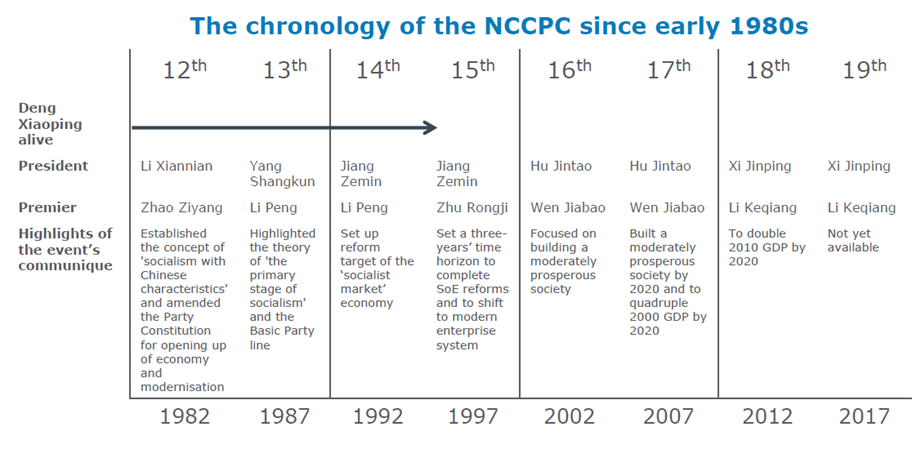-
The19th National Congress of the Communist Party of China, set for October 18, will offer a platform for President Xi Jinping to propose his long-term vision for China’s development.
The Party’s leadership has been searching for a way to practise market economics in a socialist country for some time. Since Xi is now named as one of the few ‘core leaders’ in the history of the People’s Republic of China, he is expected to propose a new ideology for the country’s future.
Before Xi Jinping took over the leadership his predecessors maintained Deng Xiaoping’s original vision to transform China’s into a ‘moderately prosperous’ society (小康社会).
"China’s growth and debt risks appear to have diminished, but there are still a slew of outstanding issues to be addressed.”
Operationally the leadership adopted a simple rule of quadrupling (翻两番) the per capita GDP for every 20 years. Deng targeted to increase China’s GDP fourfold from 1981 to 2000 and Hu Jintao also said the same for the period of 2000 to 2020.
Supply-side structural reforms will continue to be Xi’s economic policy, Deleveraging, capacity reduction, and property destocking seem to have gained some early success.
China’s growth and debt risks appear to have diminished. But there are still a slew of outstanding issues to be addressed, such as the rise of income inequalities and reliance on the property sector.
As China’s global influence continues to rise, Xi’s vision will likely be different from his predecessors and will extend beyond 2020.
In 2013, he hinted at striving for ‘the great Chinese revival’ (中华民族伟大复兴) by the 100th anniversary of the People’s Republic of China and launched his ‘Belt & Road’ initiative. The 14th Five Year Plan will require him to define a new position for China in the global economy.
Reforms on the cards at the NCCPC
• Financial regulatory reform
Financial stability tops the policy agenda in China. President Xi has reinforced the message of combating “financial irregularities” at the National Financial Work Conference, such as the rise of shadow banking and cross-sectoral financial arbitrage.
The establishment of the Financial Stability and Development Commission at the State Council level will launch a series of reforms.
• SOE reform
The official guideline on state-owned enterprise (SoE) reform had been finalised in 2015 but progress has been slow.
Contrary to expectations for a market-oriented reform, the guideline places more emphasis on the government’s and party’s control over SoEs despite outlines for a upgrade to a modern enterprise management system and transforming the SOEs’ supervisory body.
However, there are signs of acceleration on SoE reforms this year. Several rounds of SoE M&As have been announced with private sector participation. We expect the momentum to continue after the 19th NCCPC.
• Land and property sector reforms
Confirming ‘housing is for living not speculation’ in 2016, the government’s stance has become clear, i.e. maintaining reasonable property price range and providing adequate housing supply to locals.
As inventory levels have reached a multiple-year low, the chances of a massive collapse of the sector are decreased. The government can mull many longer-term solutions such as land reforms to address the housing needs.
The NCCPC
The NCCPC is held every five years, followed by seven plenary sessions (‘plenum’). The NCCPC ‘elects’ the Party’s General Secretary and decides on important economic strategies which are usually presented at the third plenum one year later.
{CF_IMAGE}
From the early 1980s to early 1990s, China’s leadership was searching for a way to practise market economics in a socialist country.
The country’s economic success in the past few decades has strengthened the belief that China cannot merely copy the Western capitalist model.
In addition, Xi may coin a new ideology as the current operational target (doubling 2010’s per capita GDP by 2020) may expire soon.
{CF_IMAGE}
Transforming China’s economy from a credit-intensive, property-led growth model will still be the authorities’ key strategy in the near term.
{CF_IMAGE}
Initiatives like capacity reduction, deleveraging and property destocking will be intact during the second half of the 13th Five Year Plan. The goal is to achieve sustainable growth underpinned by a ‘New Economy’.
Raymond Yeung is Chief Economist Greater China & Betty Wang is Senior China Economist at ANZ
The views and opinions expressed in this communication are those of the author and may not necessarily state or reflect those of ANZ.
-
-
-
anzcomau:Bluenotes/asia-pacific-region,anzcomau:Bluenotes/global-economy
NCCPC to likely see Xi’s vision for China’s future
2017-10-11
/content/dam/anzcomau/bluenotes/images/articles/2017/October/YeungWangChinaCongress_IMG1.png
EDITOR'S PICKS
-
China is a long-term project for Australian investment but acting now to strengthen investment policy is paramount.
21 September 2017 -
Asian giant mulls further regulatory reform amid convergence of financial services.
4 August 2017



